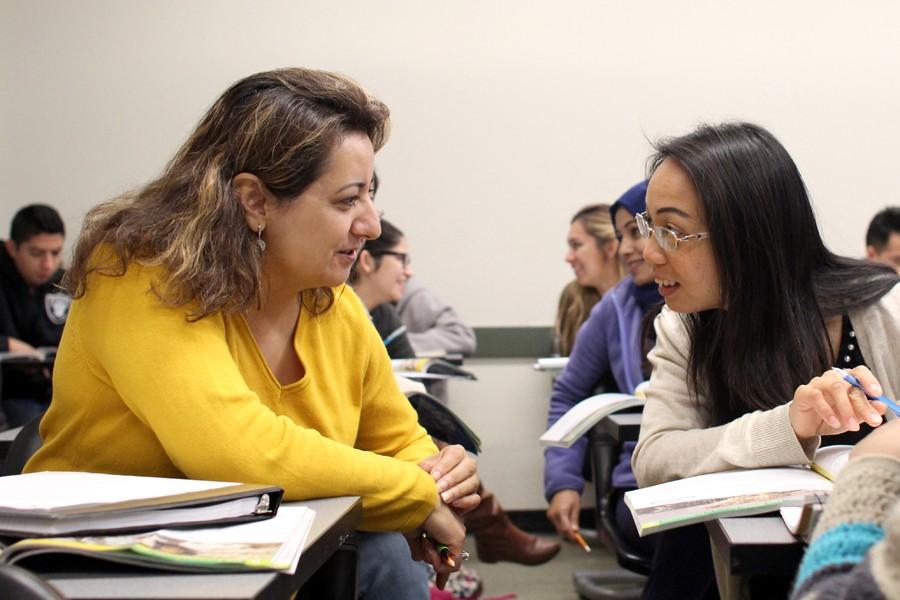ESL faces low enrollment, aims to ‘redefine success’
Full-time faculty work to increase diversity, struggle to raise numbers
Christian Urrutia / The Advocate
(Left) Nadia Shamil, from Afghanistan, collaborates with Amy Chen, from China, on a group assignment during an ESL 126 class in LA-106 on Monday.
Oct 29, 2015
In the middle of a transitional period to redefine success for students of non-English tongues, English as a second language department faculty are working to establish value in learning a second language.
“We want parents, uncles and aunts to take ESL classes, not only the fresh-outta-high-school generation,” English as a second language department Chairperson (and professor) Elisabeth Xiezopolski said. “You can be 30, 35, 40 and still transfer.”
The ESL program helps students whose first language is not English improve their reading, writing and grammar as they work toward a certificate of accomplishment in one of three categories.
Current full-time faculty are working to increase the number and diversity of ESL students, all while the former chairperson is on sabbatical.
When the recession hit the U.S. in 2008-09, Contra Costa College’s ESL department suffered several cuts, shrinking the program, English as a second language professor Gabriela Segade said.
“We can’t get back the numbers that we lost,” Segade said. “Classes were cut and, from 52 sections we went down to 28. We are now at 36.
“But we are trying to see how to redefine success in the ESL program.”
ESL assistant professor Shelley Ruby said one of the difficulties they face is getting the word out because everyone, including some faculty, think of the myths and misconceptions of the ESL.
“They think students aren’t as qualified,” she said.
Segade said, “The state doesn’t really count students as a success unless they go through ESL and move on to regular classes,” even though ESL 192, Introduction to Essay Writing, is equivalent to English 142A, and ESL 195, Advanced Reading and Composition, is equivalent to English 142B (one level below English 1A) at CCC.
Although they are set on similar platforms as regular English courses, most ESL courses count as electives and only a few are transferable, she said.
Students have the opportunity to take the regular English 1A course if they feel comfortable and up for the challenge upon completing ESL 195, Segade said. But often times ESL students find themselves easing through the regular English courses due to the rigor the ESL courses provide, Segade said.
Part of the lessons include basic essay format and composition, while incorporating “content-based ESL” books richer in context and that teach syntax to the students, she said.
“(The ESL) courses are more rigorous and students are coming out of them fairly strong,” Xiezopolski said.
Ruby said, “We want people to understand that the ESL program is not a remedial program.”
This past spring 2014 they began providing certificates of completion for students who completed the required low-intermediate, high-intermediate and advanced ESL courses with a C or better, she said.
There are three types of certificates for the different levels, Xiezopolski said.
The first is the low-intermediate ESL certificate of completion for students who successfully completed all level 2 areas, which include reading 2, speaking 2, listening/speaking 2 and grammar 2. Students must be registered in a minimum of four units in ESL and must have completed a minimum of 12 units in the program.
The second is the high-intermediate ESL certificate of completion for students who successfully completed all level 3 skills area, which include reading 3, writing 3, speaking 3 and grammar 3.
And the third is the Advanced ESL certificate of completion for students who have successfully completed all level 4 areas, which include reading 4, writing 4, speaking 4 and grammar 4.
“We want students to feel like they have achieved something, to feel proud,” Segade said.
The ESL 108 in-person orientation course was created for ESL students, which is compliant with the online course Counseling 108 for non-ESL students.
Segade said, “We do an orientation and we also meet individually with each student to interview them about their goals, double check that their placements are correct and help them select courses that best match their levels and goals.”
During the orientation there are three ESL instructors present while students go through the same orientation that Counseling 108 covers online, and then go on a campus tour, she said.
The outreach continues in order to increase numbers, but working with only four full-time faculty is difficult to organize, Ruby said.
“We are stretched out thin,” Segade said.
Ruby started full time at the beginning of this semester as former ESL Chairperson Anoosheh Borhan went on sabbatical.
Although receiving funding for tutoring from the Equity Fund, there is not enough “people power,” Xiezopolski said.
She said if there was more funding invested in recruiting more students or providing more classes, there would be a higher number of students and full-time faculty in the department.
Segade said the forms of advertisements they have undertaken include visiting local high schools, community organizations and posting fliers with ESL course information at area stores.



